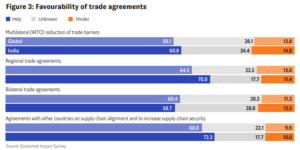
The last five years saw India’s foreign trade getting affected by international disruptions and ambitious domestic strategies. This period, marked by global upheavals such as the COVID-19 pandemic, geopolitical tensions, and fluctuating global markets, has tested the resilience and adaptability of India’s trade mechanisms. The nation is making an effort to strategically position itself as a major player in global supply chains.
The widening trade deficits, especially in FY 2023, pose significant strategic threats for the Indian economy. This necessitates not just short-term trade adjustments but also long-term economic strategies to manage and mitigate the impact of deficits. Enhancing domestic production capabilities and reducing import dependency are critical steps towards achieving a more balanced trade scenario.
READ I India needs bold reforms to tackle inequality worse than colonial era
Resilience through adversity
A report by the Global Trade Research Initiative (GTRI) provides insights into India’s foreign trade in the last five financial years ending March 2024. Despite a downturn in FY 2024, with exports and imports falling by 3.1% and 5.7% respectively, the broader five-year perspective reveals a robust expansion in India’s trade volume. Total merchandise exports surged by 32.41%, while imports grew by 31.39%. This growth trajectory reveals a critical engagement with the global economy amid significant challenges.

These challenges included not only the pandemic and its cascading disruptions but also heightened geopolitical tensions and trade policy shifts, notably the Russia-Ukraine conflict and disruptions in Red Sea shipping routes. Such conditions have necessitated a clear understanding of global trade dynamics, where India has demonstrated remarkable resilience and strategic foresight.
Foreign trade: Sectoral insights
A closer look at foreign trade data by product categories reveals major sectoral shifts. Key growth areas such as agriculture, ores, minerals, and pharmaceuticals have shown impressive gains, reflecting a strategic alignment with global demands and domestic capabilities. However, vulnerabilities surface in India’s heavy reliance on imports from China, particularly in critical sectors like electronics and pharmaceuticals. This dependence is fraught with risks, especially considering the potential for supply chain disruptions influenced by geopolitical tensions.
India’s foreign trade in the last five years reveals not just growth but a deepening of sectoral diversification. The automotive sector, for instance, has seen growth with exports of small cars and motorcycle parts expanding, reflecting India’s strengthening capabilities in manufacturing complex automotive components. This sector’s growth, while moderate, signifies India’s potential to upscale value-added manufacturing in global supply chains.
The remarkable surge in telecom, computer, and electronics products exports, which grew by an impressive 170.32% from FY 2019 to FY 2024, highlights India’s advancing technological prowess. This surge is backed by substantial investments in technology and an increased focus on producing high-value digital and electronic goods. The growth in this sector not only boosts India’s export figures but also positions it as a significant player in the global digital economy.
Supply chain reconfiguration
The “China+1” strategy is becoming increasingly relevant. Global firms are re-evaluating their supply chain dependencies on China, driven by the need to mitigate risks associated with geopolitical tensions and trade barriers. India emerges as a compelling alternative in this context, offering a combination of a vast labour market, growing consumer base, and an improving business environment, as noted in its rise in business environment rankings.

India’s strategic response has been to enhance its appeal as a manufacturing hub through bilateral and multilateral trade agreements and initiatives like the Supply Chain Resilience Initiative, in partnership with Japan and Australia. These efforts are designed to diversify supply chains and develop industrial clusters that could serve as alternatives to the current China-centric models.
India’s trade relationships with its top trading partners have also undergone notable changes, reflecting shifts in global economic alignments and regional dynamics. While trade with the US and Russia has shown favorable surges, challenges persist with partners like Hong Kong and Japan, where decreasing exports and increasing imports have led to widened trade deficits. These dynamics underscore the complexity of India’s trade relationships and the need for strategic bilateral engagements to balance trade.
For India to capitalise fully on the emerging global trade dynamics, it must address several domestic challenges. These include enhancing its manufacturing capabilities beyond mere assembly operations, reducing dependence on imported components, and improving infrastructure to lower logistics costs. Moreover, fostering a business environment that supports full-scale manufacturing will be crucial for attracting inward investment and moving up the value chain in global supply chains.
India needs to leverage its strategic initiatives, address domestic infrastructural needs, and enhance its role in global supply chains. With thoughtful policy implementation and continued engagement with global partners, India can transform its trade landscape, achieving not just resilience but also a leading role in the global economy of tomorrow. This transformation, while complex, is within reach, promising a future where India not only participates in global markets but shapes them.
